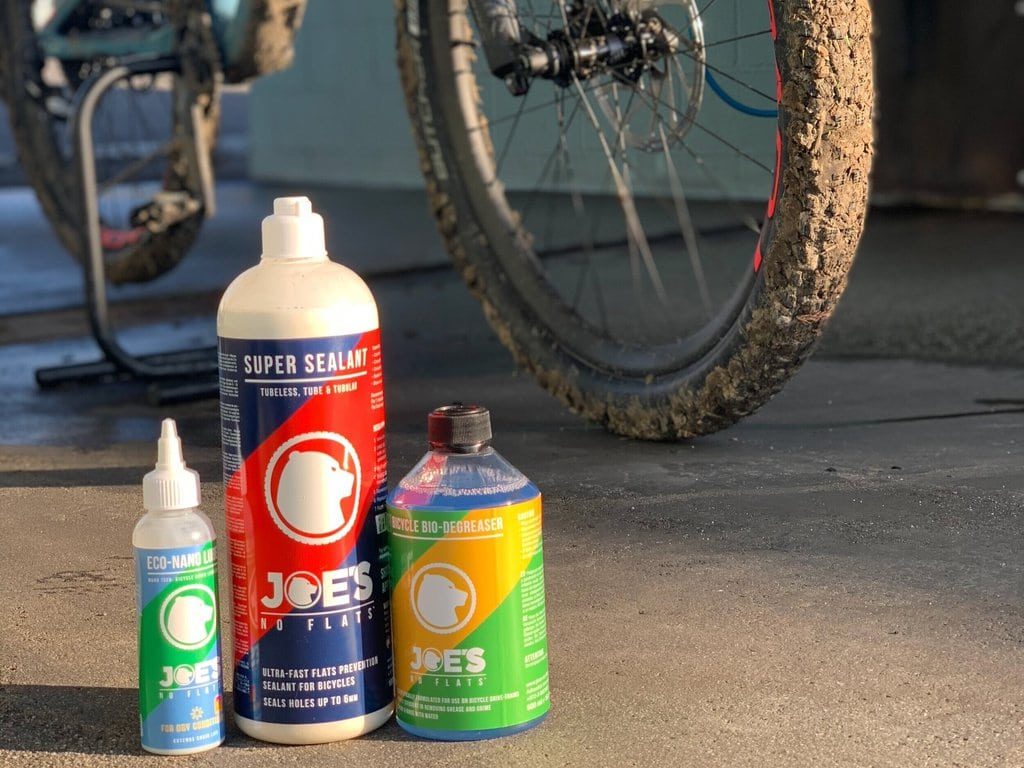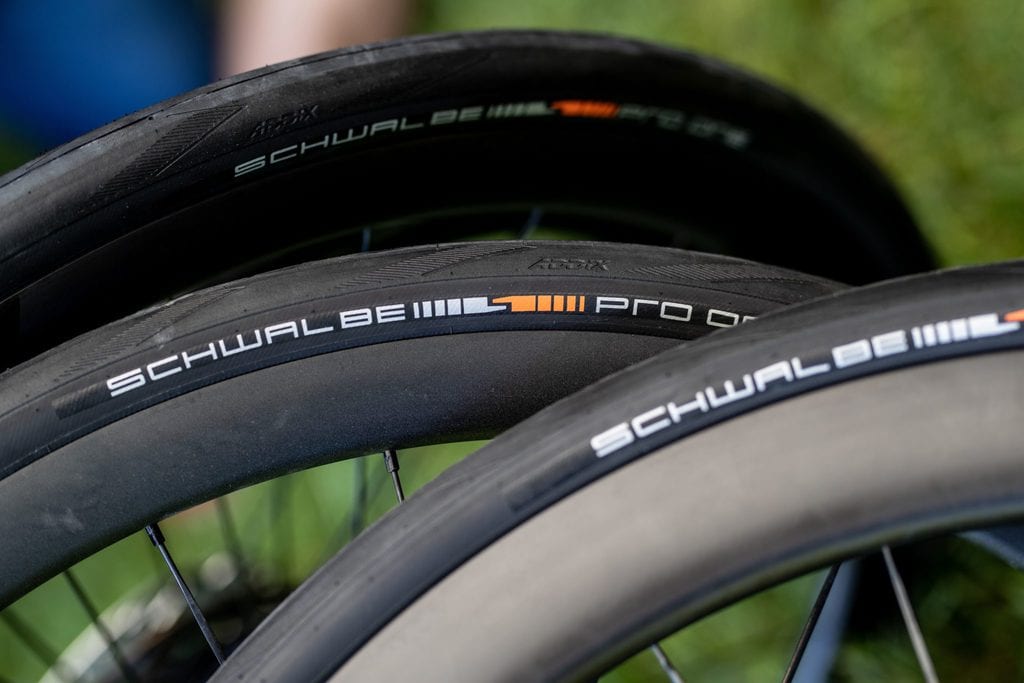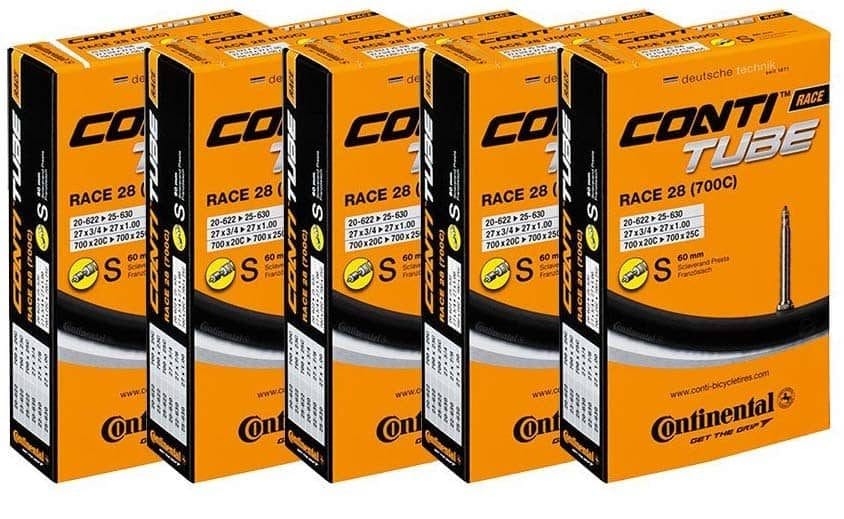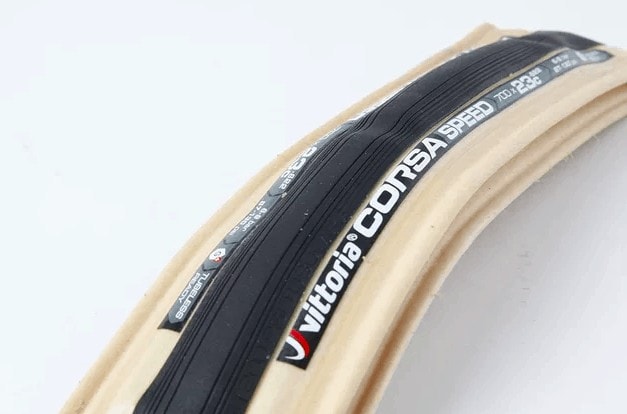Tubeless vs Clincher vs Tubular – Everything You Need to Know
You’ve heard of tubeless tires, clincher tires, and tubular tires, but you aren’t really sure what the differences are.
What are the pros and cons of each and which will best serve your needs?
It’s a complicated subject that we’re here to help shed some light on, so you can make the best decision for your cycling needs.
- Clinchers have been the most popular type of tire for a long time. A clincher tire is constructed with a bead that hooks into the rim of a bike wheel. When the tire flats, you remove the tire and replace the inner tube.
- Tubeless tires are the up and comers, prized by mountain bikers due to their puncture-resistant qualities and their ability to be run at low pressures.
- Tubular tires are a combination tires and tubes that are typically adhered to the rim with glue or a special tape. When they flat, they need to be repaired or replaced.
Let’s take a deeper look in to various aspects of how they’re different.
On This Page
Wheelset Compatibility
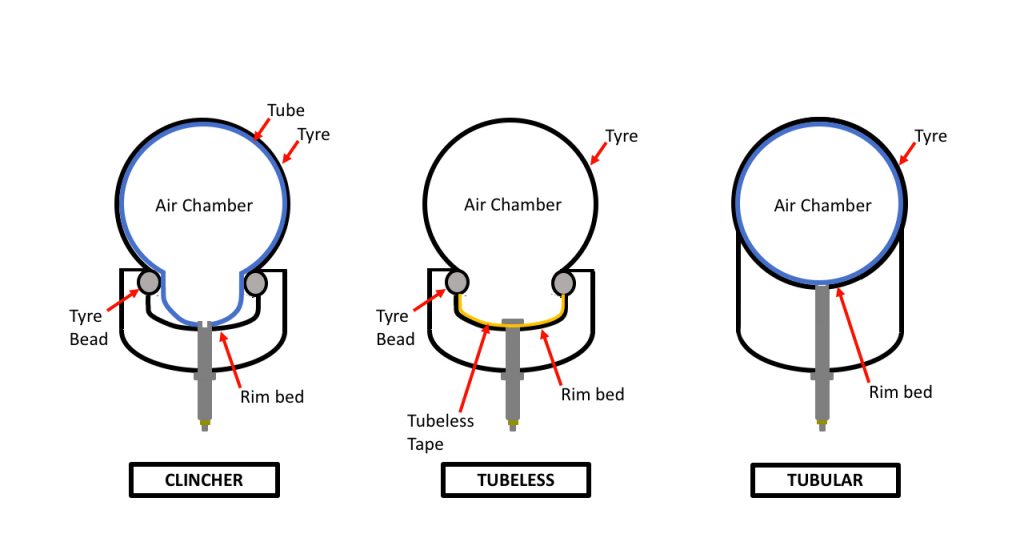
One of the biggest challenges in the early design of bike tires was figuring out a way to attach them to the wheels’ rims. Early designs included a system of clips or wires. These designs were too complicated and ultimately failed. Eventually, wheel manufacturers settled on the use of a tubular tire that could be glued to the rim. This is the same design used by tubular tires today.
Later on, wheel manufacturers came up with a simpler method of attaching a tire to a rim, by using a hooked rim and beaded tire. This idea gave birth to the clincher tire.
Both clincher and tubeless style tires are designed to be used on a hooked rim. As such, a clincher tire can be used on a tubeless rim because it uses a tube. However, a tubeless tire cannot be installed on a clincher rim because clincher rims are not designed to be airtight.
It is possible to use rim tape to convert a clincher rim to a tubeless rim; however, this is generally not suggested for safety reasons.
Because tubular rims lack the necessary hook to hold tubeless and clincher tires onto the rim, they cannot be used for either.
Read More :
Tire Construction
The construction of these tires is really what sets them apart.
While all three tires incorporate a tread, casing, and sidewall, how they are tied together varies.
A clincher tire is made up of 2 separate pieces.
- The tire casing wraps around the bead, which is usually constructed of steel or kevlar. The bead then hooks into the rim.
- The inner tube is placed inside of the tire and then mounted to the rim before being fully inflated. The cross-section of the tire is shaped like a U. A bead is built into each end of the U and circumvents the tire.
Tubeless tires are similar to automobile tires.
They consist of a beaded tire with no tube that is attached to the rim and inflated with a high-pressure air pump.
The air is held into the tire either through a rubber layer on the inside of the tire or by applying a liquid sealant.
Tubular tires are 1-piece.
They take the same tube and tire concept and combine it together into a single piece of tire. Sometimes tubular tires are also referred as sewn-ups.
The casing is sewed completely around the inner with no bead to hold it to the rim. Instead, the entire tube/tire is then installed onto a rim using glue or a special adhesive tape.
Overall Tire and Wheels Weight
Tire weight can be a bit deceiving. Ideally, you want to view them as an entire wheel system instead of individually.
Tubular tires are generally heavier than clincher tires; however, in a grander scheme of things, they’re actually lighter.
How?
You need to look at the entire wheel system – tires, tubes, and wheelset.
Although tubular tires are heavier than most clincher tires, tubular wheelsets are lighter because they don’t require the heavier hooked rims that both tubeless and clincher tires require. Therefore, the combined weight of the wheelset and tires are actually lighter.
For example, the Campagnolo Bora Ultra 35 weighs 1,360g for the clincher version and 1,170g for the tubular version.
Clincher tires also require the inner tube, which weighs between 80 to 100g each. You can shave off some weight if you opt for latex instead of the common butyl tubes.
For example, Vittoria Corsa’s 700×25 clincher tire weighs 255g compared to 290g for the tubeless and 290g for the tubular. The popular Conti GP5000 weighs 220g compared to 300g for its tubeless version.
The table below shows a quick comparison between a clincher vs tubular setup on a Campagnolo Bora Ultra 35 with Vittoria Corsa tires.
| Set Up | Wheelset | Tire | Inner Tube | Total |
|---|---|---|---|---|
| Clincher | 1,360g | 255g | 80g | 1,695g |
| Tubular | 1,170g | 290g | n/a | 1,460g |
Ride Quality and Performance
There’s a lot to consider regarding ride quality and performance when it comes to tire type. And while much of this is subjective, there are some important characteristics specific to each tire type to point out.
Tubeless tires generally have lower roll resistance than clincher tires.
Why?
Some rolling resistance (RR) is created by the friction between the tire and the inner tube on clincher tires. One of the well-known tricks among cyclists to minimize this is to rub some talcum powder in the inner tube before installing them. With no inner tube to create friction, that rolling resistance doesn’t exist in tubeless tires.
That said, there are some exceptions. Clincher tires paired with latex inner tubes eliminate much of the friction, resulting in rolling resistance that is comparable to a tubeless tire.
Tubular tires also have distinct performance advantages.
Because these tires are not held to the rim by pressure, you don’t need to worry about blowing them off the rim. This is especially critical with carbon rims that are prone to heating up on descents when using rim brakes.
That said, with more and more high-end bikes adopting disc brakes, this problem is quickly becoming a non-issue.
In terms of ride quality, many pro cyclists swear by tubulars for racing due to their supple casings that are made of cotton, polyester, and silk, and their thinner, more flexible tread layers.
Read More : The Beginner Cyclists Guide to Disc Brakes
Puncture Resistance Qualities
Better puncture protection is perhaps the number one reason tubeless tires have skyrocketed in popularity in the last couple of years.
Tubeless tires are immune to the dreaded pinch flat.
Also known as a snake-bite puncture, this occurs when the inner tube becomes pinched in between the tire and the rim, resulting in two tiny telltale snakebite holes.
Tubeless tires are also popular because they can be paired with a liquid sealant that allows the tire to essentially self repair itself when punctured. The sealant will also eventually dry out or dissipate, so you need to remember to periodically top-up. Neglecting to do so could result in you being stranded in the middle of the woods.
That said, in the rare event that a tubeless tire is gashed, it will spew all of that sealant on your clothes and bikes making for a difficult clean up process. Worse of all, the poor guy behind you in the bunch will be splashed all over too.
There are good and bad when it comes to punctures for a tubular tire.
The good news is that since the tube is encased in the outer casing, there is no chance for a pinch flat. The other advantage of a tubular is that it is still rideable even after being punctured, which is why many pros still like them. You can still keep moving forward while your team car makes its way up to you.
Johan Vansummeren won the Paris Roubaix in 2011 riding a flat tire for the last 5km.
The bad is that once you puncture a tubular tire, it’s difficult to change in the field as it requires glue or tape. Repairing a punctured tubular tire involves unstitching the casing to get to the tube, then repairing the tube and putting it all back together. That’s a process no one wants to go through.
Once a clincher tire fully deflates, it becomes very dangerous to ride on.
A complete clincher blowout on a descent can be disastrous. This, plus a clincher tire’s susceptibility to pinch flats makes it most prone to punctures.
Read More : 11 Easy Ways to Minimize Punctures
Ease of Tire Installation
Most cyclists can install their own clincher tires without having to visit a bike shop. It’s also one of the reasons why cyclists prefer clincher as it can be quickly replaced with a new inner tube from the saddlebag.
The tire has to be partially removed on one side to replace the inner tube. Some can get it done in under 5 minutes, while others would take up to 10 minutes or more.
You’ll save some time and energy if you inflate the tire using a CO2 inflator instead of a handpump.
Installing tubeless tires can be a real challenge.
Although design advancements in tubeless tire and rim technology have made DIY installation possible, it’s still not easy.
In order to seat the tire bead correctly, you’ll need a strong gush of air which most standard floor pump is incapable of. Bike mechanics use an air compressor for this.
Alternatively, you can also look for floor pumps with a chamber that stores the air up to 160psi before being released at once.
Besides, tubeless tires also require liquid sealants to create an airtight seal between the tire and rim. This makes for a potentially very messy installation process.
Tubular tires installation can be a chore.
Gluing on a tire is a messy process. It’s also not a quick one as installation requires drying time before a bike can be ridden.
And while new adhesive tapes do make the installation process easier, it’s still not a simple installation process and tapes generally aren’t as strong as glue.
This is why you generally only see tubulars used by racers, who can simply trade out an entire wheel from their support vehicle if they get flat, leaving the repair of the punctured tire to a team mechanic.
Read More : 9 Bike Maintenance Issues Faced by Mechanics Daily
Tire Pressure
One of the main advantages of tubeless tires is their ability to run at low tire pressures. This makes them especially advantageous to mountain bikers and touring cyclists who like to run tires at low pressures to improve traction or, in the case of touring cyclists, shock absorption.
Clincher and tubular tires don’t have this ability as they require a certain amount of air pressure to prevent the tire from coming off the rim. Attempting to run these tires at lower pressures is a recipe for disaster.
Tubular tires have the advantage at the high end. Because they are an enclosed tube, they can be run at very high pressures, which is part of why they are preferred by many pro cyclists. Attempting to run clincher or tubeless tires at very high pressures can cause them to blow off the rim.
Read More : The 7 Factors that Affect Tire Pressure
Tire Availability and Choices
The variety of tires you have to choose from can be a significant factor in deciding which tire style to use. Consider the budget you have to spend for tires as well as the performance and durability you need from the tire.
Clincher tires are widely available everywhere.
You can expect to find many different varieties of clincher tires from low-end budget tires to high-end racing tires.
You’ll also have many different manufacturers to choose from. They are readily available from online retailers or at your local bike shop.
Tubeless tires may not be as ubiquitous as clincher tires, but that’s quickly changing.
Currently, you’re only likely to see them on high-end mountain bikes and some road bikes. However, the market for tubeless tires is quickly growing.
With the advantages they offer in the areas of puncture prevention and the ability to run lower tire pressure, they are quickly becoming the tire of choice for serious mountain bike riders.
As such, more and more tire manufacturers are putting out new lines of tubeless tires.
Tubular tires are getting scarce these days.
The difficult installation process required by tubular tires means they are reserved for high-end race-ready road bikes. As such, tubular tires are more expensive and many retailers now don’t stock them due to the low demand among recreational cyclists.
Tire Cost
Price is a significant factor when considering which tire style to go with. Not only should you consider the price of the tire, but also the cost associated with repairing a tire.
Given their popularity, a wide variety of clincher tires can be found at every price range.
As clincher tires are typically found on all entry-level bikes, expect to find many budget options here. There are plenty of expensive high-performance clincher tires with lightweight advanced rubber compounds too.
Although inner tubes are generally inexpensive, they do present a cost as they need to be replaced when punctured. Riders can save money here by learning to repair tubes themselves.
Tubeless tires are more expensive than clincher tires.
This is largely because most models today are either mid or premium range. As such, you find better rubber compounds in a tubeless tire than you will in a clincher tire.
But as tubeless tires become more and more popular, expect the price to come down as budget versions are made available. For now; however, expect to pay more for a tubeless setup.
Keep in mind that you will also need to invest in a tubeless bike pump in order to save fitting costs at the bike shop. Rim tapes and valves are also required for installation. In terms of ongoing costs, you will need to top off the sealant in tubeless tires periodically.
Tubular tires are generally the most expensive among all.
Their market is predominantly centered around competitive-level cyclists who demand the best tires.
You also need to consider the ongoing cost. Because tubular tires are so difficult to repair, they are generally scrapped when punctured. This means you’ll be buying a completely new tire every time you flat. Unless you take the time to learn how to repair them, that can get expensive very quickly. And while it’s possible to find low-cost tubular tires, consider the added expense of glue or tape for installation.
Summing Things Up
As with many options in the world of cycling, deciding on what tire type is right for you comes down to the type of riding you’re doing.
- Clincher for general riding. If you’re looking for a good all-around tire that requires the least amount of fuss and expense when it comes to maintenance, installation, and repair, then clincher tires are clearly the choice for you. They are the cheapest of the three types, easy to install and offer plenty of options at both the low and high end.
- Tubeless for off-road riding. If you’re into gravel riding, mountain biking, touring, or other off-road endeavors and can afford the extra expense associated, then it may make sense for you to go tubeless. The ability to run these tires at lower pressures coupled with their puncture resistance makes them an attractive tire for these purposes.
- Tubular for racing. If you’re a competitive racer with high-performance demands and you can afford the expense of professional services at a bike shop or don’t mind doing a bit of maintenance yourself, then you might consider tubular tires. They offer unparalleled performance for road bike racers.

